This post contains affiliate links, which means I may earn a commission if you purchase through those links (at no extra cost to you).
I grew up making Orange Marmalade the old-fashioned way: soaking citrus overnight and boiling it rigorously to extract the natural pectin in the rind. When you follow my technique, you don’t need to add any store-bought pectin, and you get the best, cleanest-tasting marmalade.
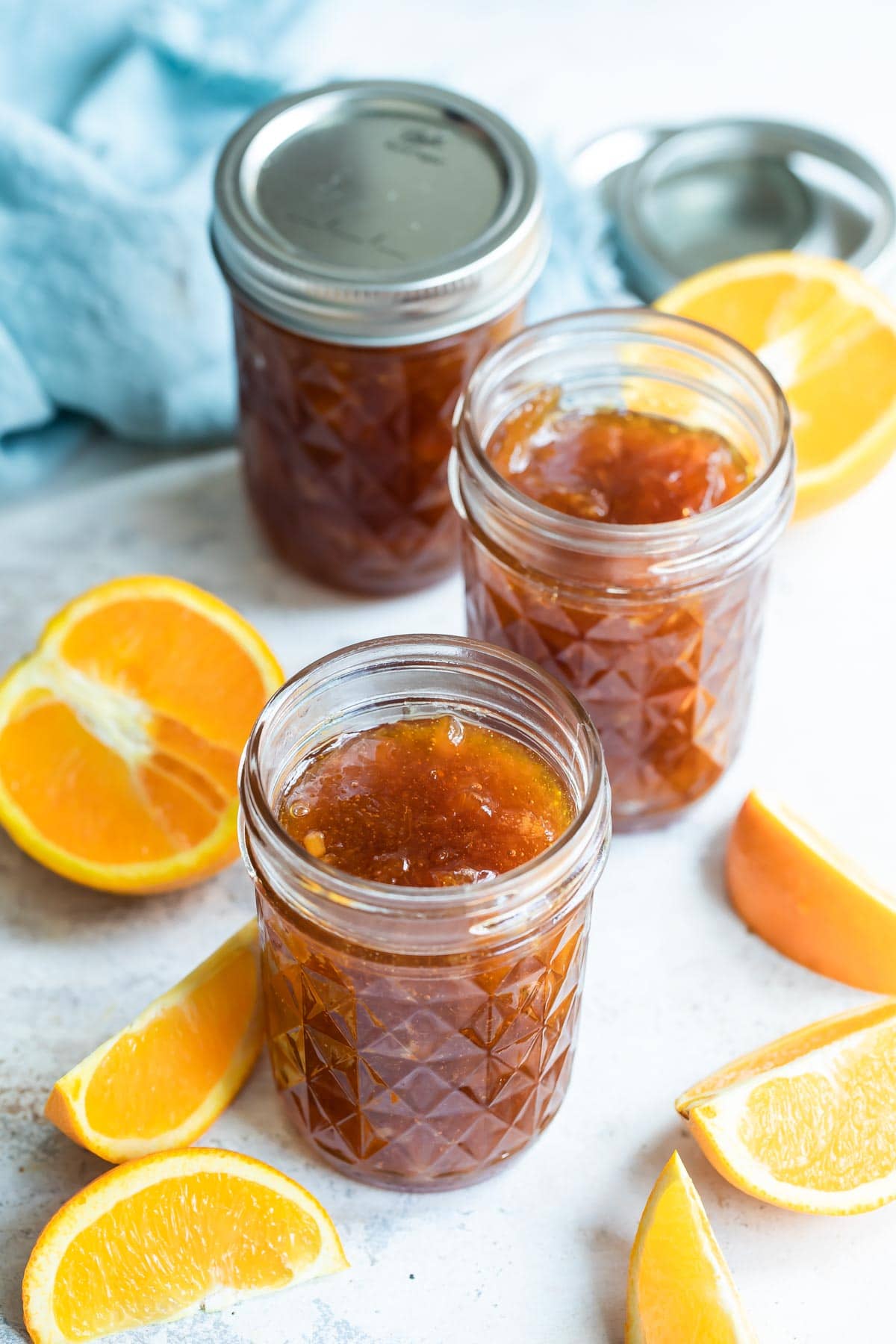
Nearly 1,000 5-star reviews prove this unfussy technique is simple and easy to follow. I also include my handy “cold plate test” so you can know for sure whether your marmalade is done or needs a little bit more time on the stove.
Home cooks everywhere are putting their abundant citrus to use to make their own homemade marmalade, and now you can, too. This recipe makes about 3 quarts total, or 12 (8 ounce jars). It freezes beautifully or you can process it in a water bath for canning.
Table of Contents
Marmalade Ingredients
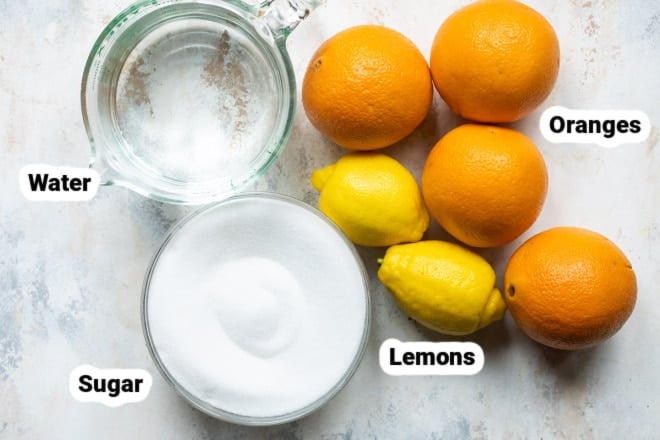
At a Glance: Here is a quick snapshot of what ingredients are in this recipe.
Please see the recipe card below for specific quantities.
- Oranges: This recipe is made with regular seedless oranges. You can definitely substitute Seville oranges if you can find them. They are only in season from the end of January to mid-February, but they have an intense flavor that is ideal for marmalade.
How to make Orange Marmalade
- Using a sharp knife, cut oranges and lemons in half crosswise, then into very thin half-moon slices. Discard any seeds. In a large pot (stainless steel), add the sliced oranges, lemons, and any fruit juice.
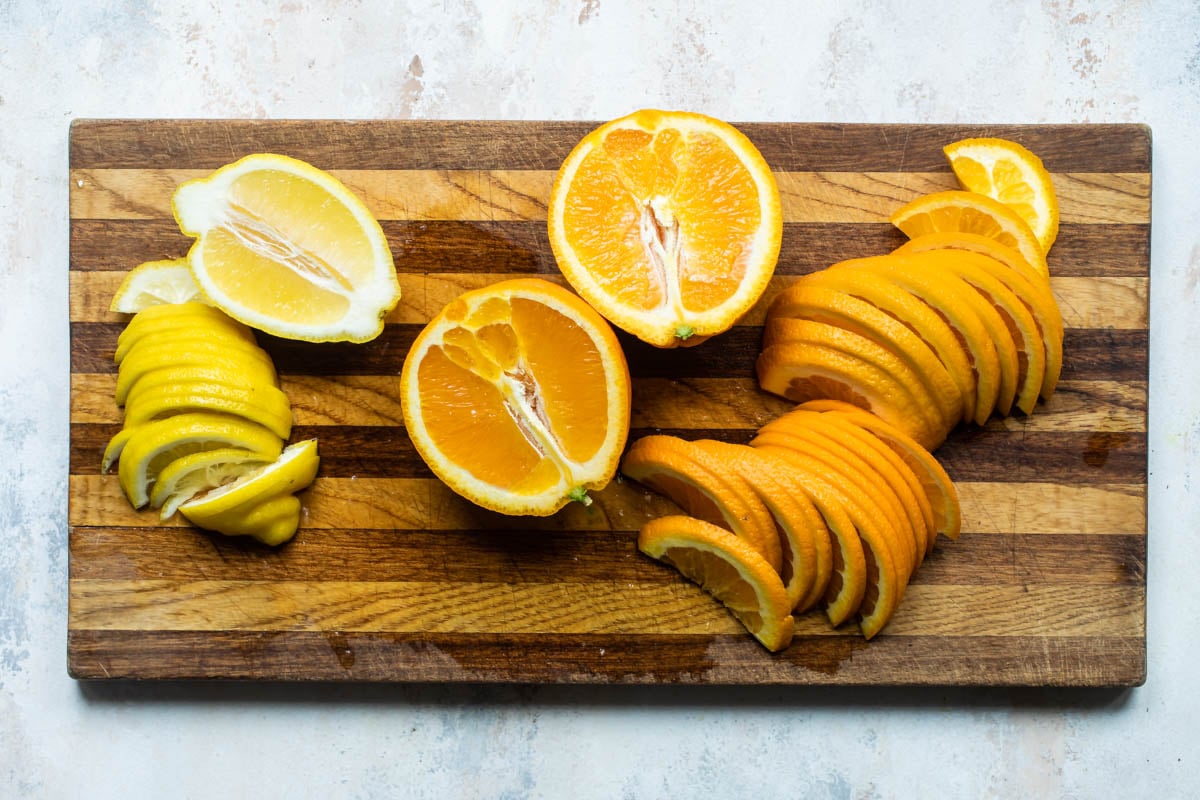
- Add water and bring the mixture to a boil over medium heat, stirring often. Remove from the heat and stir in the sugar until it dissolves. Cover and let stand overnight at room temperature.
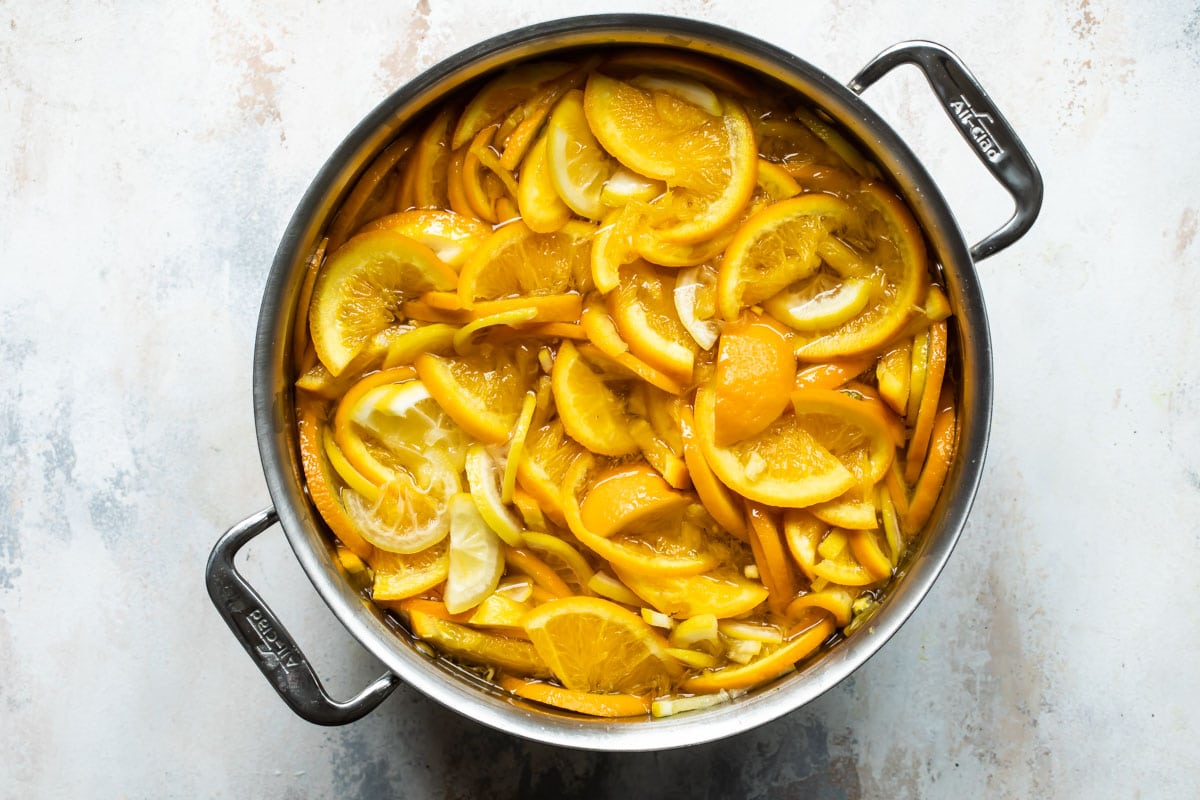
- The next day, bring the mixture back to a boil in the pot or saucepan. Reduce heat to low and simmer uncovered for 2 hours. Turn heat up to medium and boil gently, stirring often, for another 30 minutes. Skim off any foam that forms on the top. Cook until it reaches 220 degrees on a candy thermometer (you must hit this temperature for the natural pectin to gel with the sugar).
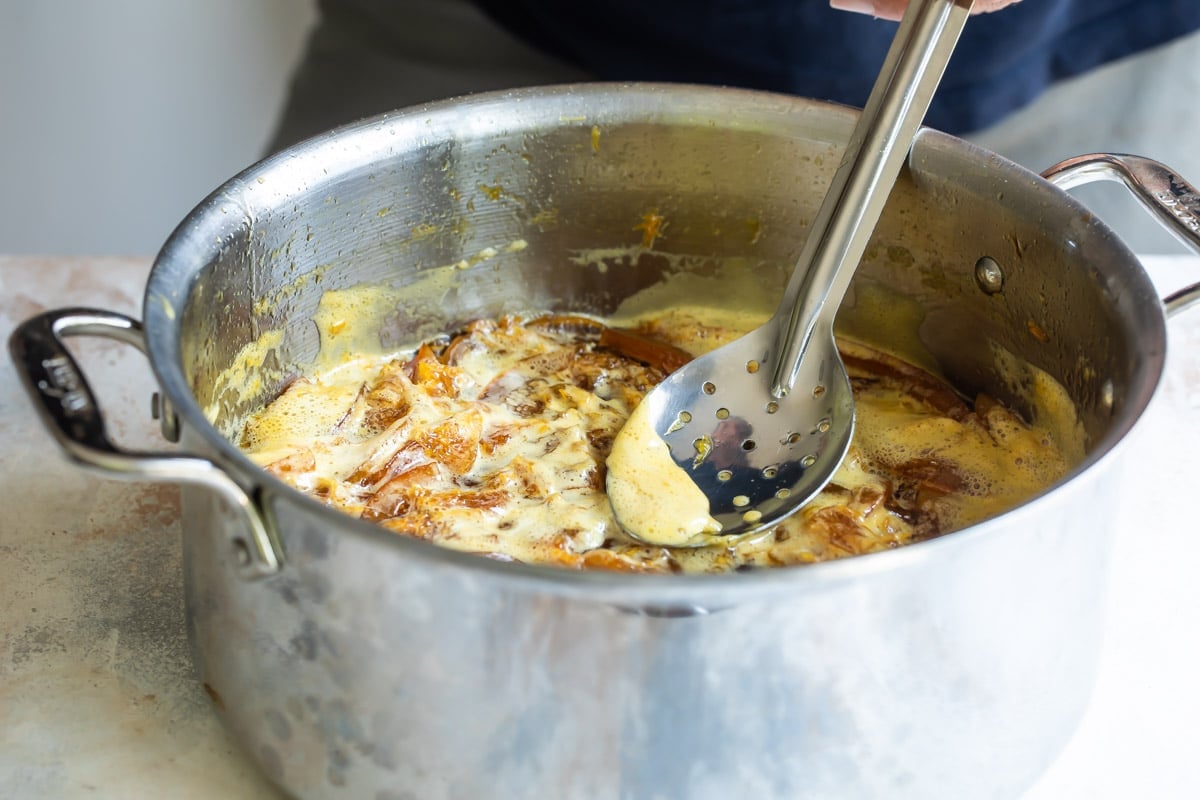
- To test if the marmalade is ready, place a small amount on a plate and refrigerate it until it’s cool but not cold. If it’s firm (neither runny nor hard), it’s ready. It will be a golden orange color. If it’s still runny, continue cooking it; if it’s hard, add a bit more water.
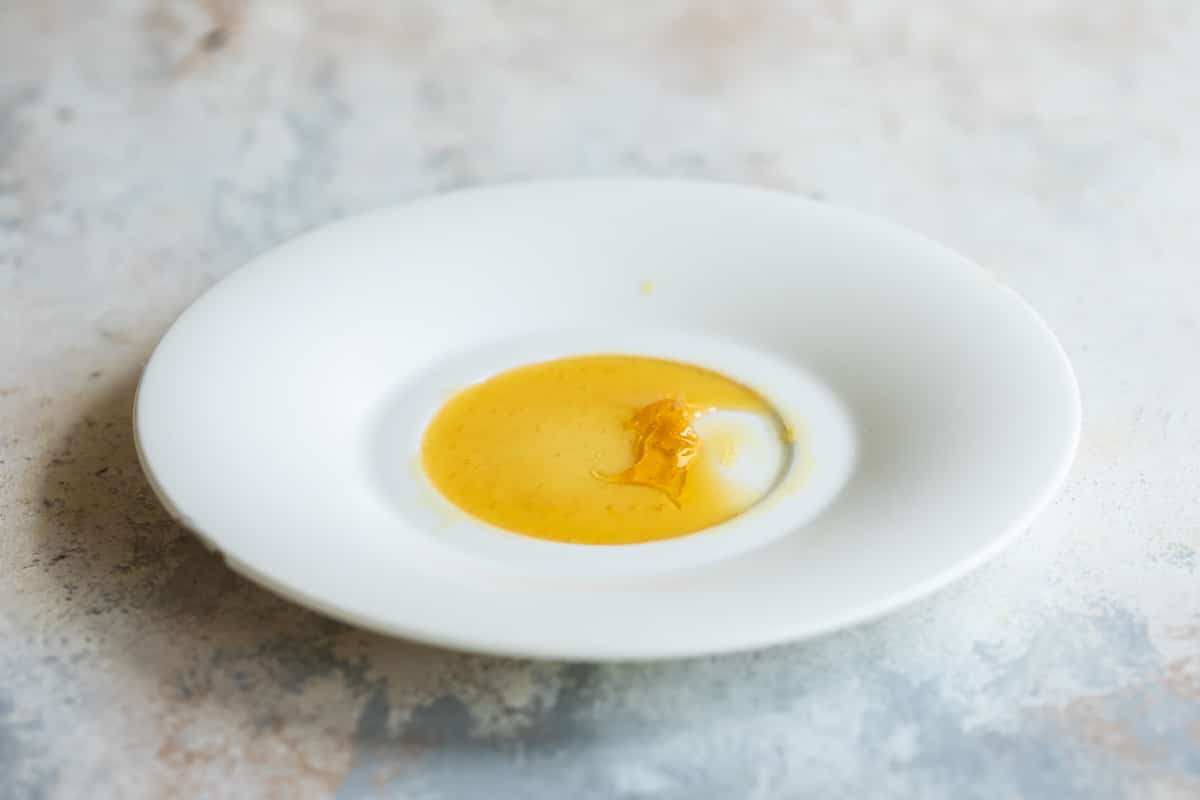
- Pour or ladle the marmalade into clean hot mason jars (I use this wide-mouth jar funnel for this recipe and so many others). Wipe the rims thoroughly with a clean damp paper towel, and seal with the lids. Chill in the refrigerator. It may take 24-48 hours for the natural pectin to set up properly.
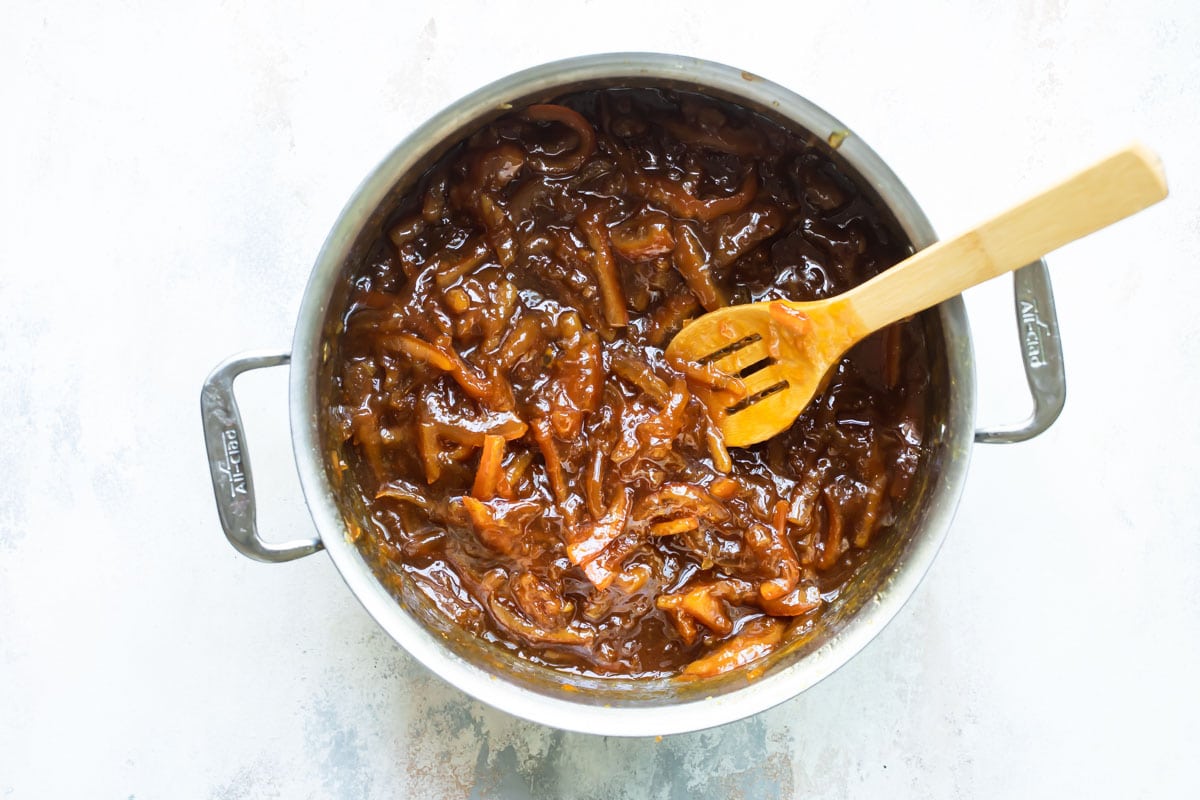
Orange Marmalade Recipe Variations
- Pectin: While many jam and jelly recipes require added pectin, you don’t need to add any here. Pectin is naturally concentrated in the pith of the orange (the bitter white part under the peel). This recipe coaxes out that natural pectin by letting the citrus soak overnight and then boiling it rapidly until enough water has evaporated that the mixture can reach 220 degrees.
- Agave nectar: Agave cannot penetrate and sweeten the peel as well as sugar can. When I tested it, the consistency was fine, but the rind tasted like raw rind. I don’t recommend this substitution.
- Low sugar: I haven’t tested low-sugar/alternative sweeteners in this recipe other than agave as listed above nor have I tweaked the amount of sugar in the recipe. I recommend seeking out recipes from experts in that area.
- Slow cooker: While it is technically possible to make marmalade in your slow cooker, it really depends on the power of your appliance. I no longer recommend that method because it isn’t reliable enough.
- Instant pot: Even with an overnight soak, the IP doesn’t break down the rind sufficiently. I don’t recommend this method.
Marmalade Recipe Tips
- Yield: This recipe makes about 3 quarts (96 ounces) of marmalade.
- If using 1/2-pint (8 ounce) jars, you’ll need 12.
- If using 1 pint (16 ounce) jars, you’ll need 6.
- If using the tiny jelly jars (4 ounce), you’ll need 24.
- Cold-plate test: To test if your marmalade is ready, spoon some hot marmalade on to a small plate and put it in the freezer to chill, or spoon some over an icy cold plate fresh from the freezer. If the mixture wrinkles slightly when you draw a spoon or finger across it, it has reached the setting point and is ready to go! If not, keep boiling and make sure the temperature reaches 220 degrees.
- Set-up time: Orange marmalade takes 24-48 hours for the natural pectin to set up completely. If it’s is still a little runny looking when it cools, check again in a day or two.
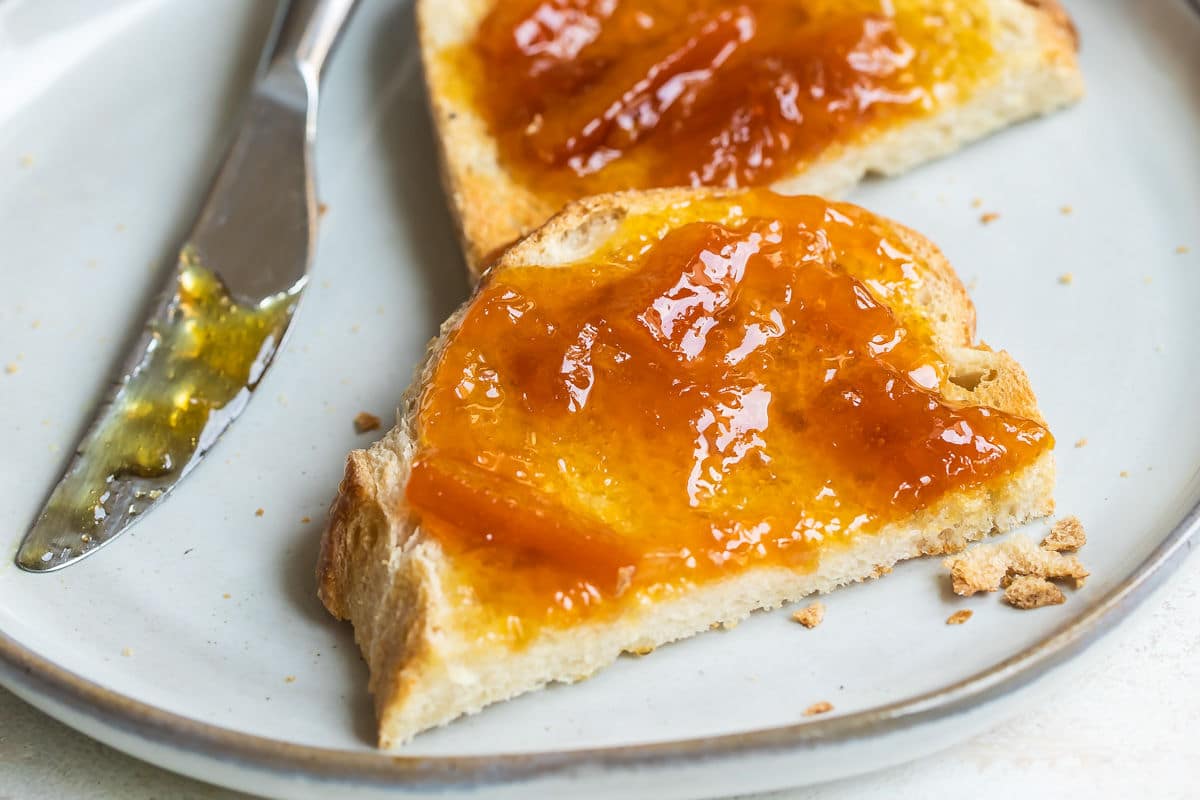
Storing and Canning Orange Marmalade
Storage: Store covered in the refrigerator for up to 1 month.
Freezer: Pack in freezer-safe containers or jars leaving 1/2-inch of headspace for expansion. Label, date, and freeze for up to 3 months. Thaw overnight in the refrigerator.
Canning: If putting up for storage, use a hot water or steam canner with a rack to properly seal lids on canning jars according to canning instructions. Otherwise, refrigerate and use within the month. Or, freeze for up to 3 months.
Frequently Asked Questions
Pectin is naturally concentrated in the pith of the orange (the bitter white part under the peel), so you don’t need to add any here. This recipe coaxes out that natural pectin by letting the citrus soak overnight and then boiling it rapidly until enough water has evaporated that the mixture can reach 220 degrees.
While it is technically possible to make marmalade in your slow cooker, it really depends on the power of your appliance. I no longer recommend that method because it isn’t reliable enough.
Even with an overnight soak, the IP doesn’t break down the rind sufficiently. I don’t recommend this method.
Agave cannot penetrate and sweeten the peel as well as sugar can. When I tested it, the consistency was fine, but the rind tasted like raw rind. I don’t recommend this substitution.
I don’t recommend making this recipe in a regular cast iron pan. It should be made in a non-reactive pan. Enameled cast iron, stainless steel, and non-stick are best and will not affect the color or taste of the marmalade
More fruit recipes
Pie and Tart Recipes
Fresh Fruit Tart
Fruit Dessert Recipes
Apple Crisp with Oatmeal
Cake Recipes
Lemon Bundt Cake Recipe
Muffins and Quick Breads
Banana Muffins
Join Us

Orange Marmalade
Equipment
- Jar funnel (for wide mouth jars)
Ingredients
- 4 large seedless oranges scrubbed clean (about 3 pounds or 8 cups slices, see note 1)
- 2 lemons (about ½ pound or 1 cup slices)
- 8 cups water
- 8 cups granulated sugar
Instructions
- Cut oranges and lemons in half crosswise, then into very thin half-moon slices. Discard any seeds. In a large stainless steel pot, add the sliced oranges, lemons, and any accumulated juices.
- Add water and bring the mixture to a boil, stirring often. Remove from the heat and stir in the sugar until it dissolves. Cover and let stand overnight at room temperature.
- The next day, bring the mixture back to a boil. Reduce heat to low and simmer uncovered for 2 hours. Turn heat up to medium and boil gently, stirring often, for another 30 minutes.
- Skim off any foam that forms on the top. Cook the marmalade until it reaches 220 degrees (you must hit this temperature for the natural pectin to gel with the sugar).
- To test if the marmalade is ready, place a small amount on a plate and refrigerate it until it's cool but not cold (see note 4). If it's firm (neither runny nor hard), it's ready. It will be a golden orange color. If the marmalade is runny, continue cooking it; if it's hard, add a bit more water.
- Pour the marmalade into clean hot mason jars; wipe the rims thoroughly with a clean damp paper towel, and seal with the lids. Chill in the refrigerator. It may take 24-48 hours for the natural pectin to set up properly.
Recipe Video
Notes
- Oranges: This recipe is made with regular seedless oranges. You can definitely substitute Seville oranges if you can find them. They are only in season from the end of January to mid-February, but they have an intense flavor that is ideal for marmalade.
- Yield: This recipe makes about 3 quarts (96 ounces) of marmalade.
- If using 1/2-pint (8 ounce) jars, you’ll need 12.
- If using 1 pint (16 ounce) jars, you’ll need 6.
- If using the tiny jelly jars (4 ounce), you’ll need 24.
- Storage: Store covered in the refrigerator for up to 1 month.
- Cold-plate test: To test if your marmalade is ready, spoon some hot marmalade on to a plate and put it in the freezer to chill, or spoon some over an icy cold plate fresh from the freezer. If the mixture wrinkles slightly when you draw a spoon or finger across it, it has reached the setting point and is ready to go! If not, keep boiling and make sure the temperature reaches 220 degrees.




Having a hard time finding lemons right now. Will lemon juice work?
Hi Marta, I can’t think why not. I don’t know exactly how much you would use, but this is a very forgiving recipe. On the second day, you just basically cook it until it thickens (I have more exact instructions in the recipe, but that’s what you’re aiming for). If it’s too thick, you can add more water. If it’s too thin, you just cook it longer. So try lemon juice, maybe do like 1/4 cup? 1/2 cup? Something like that. Good luck! Thanks. – Meggan
Hi, I made mine with 6 oranges and 3 lemons, but with the same amount of sugar and it tastes great. However, it came out really thick after it was refrigerated. Can I return it to the pot and water and warm it to mix?
Thanks,
Peyman
Hi Peyman, yes, you can go ahead and return it to the pot and add water! -Meggan
Hi, you say over night, is there a specific amount of time, I made my batch by 1pm, at 9pm it’ll be 8 hrs sitting. Also can you substitute real orange juice for water?
My marmalade is simmering and has been for 30 mins and temp is already 200 but it’s still runny any help would be appreciated thank you
Hi Nikki, you need to simmer it for 2 hours and 30 minutes total, so that might be why it’s still runny. After the 2 1/2 hour simmer, bring it 220 degrees and see where you’re at. Thank you! -Meggan
Hi Meggan, I love the simplicity of this recipe after having made much more complicated versions in the past. Mine turned out thick and chunky which is how my husband loves it. To simplify it even further I used all the quantities you suggested but reduced the water by 2 cups. This reduces the final boiling time. I boiled mine fairly rapidly from the start and it was ready in about 45 minutes. I soaked my oranges without adding the sugar until I reheated them for the final cook. This has the advantage of bringing the mixture to a boil quickly without worrying about burning. Thanks for sharing this great recipe.
Hi, haven’t tried your recipe yet, but will do so tomorrow, so far since March I have made a total of 50 pints, grape, grape/pomegranate, blueberry, apple and orange jellies. My mom taught me many moons ago, her favorite and mine was elderberry. So instead of water, I was thinking real orange juice no water added, what do you think, stay safe in these strange times.
I used your recipe but used tropicana orange juice instead of water. Came out delicious.
I’m definitely going to try it this way next time Mark! Thanks for the great idea!! -Meggan
Wow! What a difference homemade makes! The taste is so fresh and I’m a convert. This was so easy and worth the effort.
Hi Meggan,
I started this recipe, but only realized I didn’t have quite the 8 cups of sugar. Do you have any thoughts on using less sugar? And how this may affect the marmalade? Or should I really stick to the full amount?
Thank you!
Hi Lena, I am not sure about using less sugar. I’ve made this with agave and it didn’t really firm up well, I’m wondering if the same thing would happen with using less sugar. Since you started the recipe, you probably finished it by now. I was wondering what happened? Sorry about that! -Meggan
Meggan,
It took a lot longer, but turned out delicious with 5 cups of sugar. It thickens well, but possibly the orange peel remains a bit bitter since it absorbs less sugar. I am really happy with the outcome, though, perhaps next time I will try slicing oranges a bit thinner. Thank you so much!
Lena
I’m making the marmalade in the crock pot and I just turned it off after 4 hours on high, uncovered. What is supposed to happen with the orange peel? It is very soft but it is still whole with the peel, pith and some fruit attached.
Hi Debbie, you leave the orange peel in. I know it sounds weird, but you just eat it! It tastes good! That’s what makes it marmalade. It becomes sweet and soft and you just eat it. I remember telling this to my mom too and she was like “WHAT!” But yes. That’s how it is. You eat the peel. Please let me know what you think once you’ve tasted it, if you’re bored and feel like replying. Take care! -Meggan
Hi, Meggan! I tasted the peels and they are yummy. It’s just that there are more peels than there is jam. It would be like you’re spreading the peels on your toast. And they are about 2 inches long. It tastes great but it definitely doesn’t look like run-of-the-mill orange marmalade. I thought I missed something in the recipe. So my first batch of orange marmalade is a winner! I’ll be making it again in the crock pot since it is so simple. Thanks!!
Hi Debbie, yeah, I know exactly what you mean. I felt the same way the first time I made it. Literally just like spreading orange peels on your toast, LOL! Yes. Well I don’t remember if the ratio was more peels than jam, but either way yes. Peels on toast. I thought about it and I tried to figure out how to fix that, but I didn’t come up with anything. Ultimately the peels needs to be thinner and smaller, but in a non-commercial setting it’s just not feasible. I have a mandoline which I tried to use for slicing the oranges, but it’s just a disaster. I imagine in the factories where they make actual marmalade, they can cut the peels really thin into the tiniest slivers. We could do that by hand here, but it would take SO much time, if it even worked well. So. That’s how we ended up here – peels on toast. 🥴 Thanks for your feedback. -Meggan
Hi, Meggan! I spent about 5 minutes with my kitchen shears and now I have orange marmalade with chunky peels. It’s a lot easier to scoop out. Thanks again for the DELICIOUS and EASY recipe!
Is it okay if the sugar went in earlier than the water boiling? I was working with a friend and she poured in the sugar a bit too early.
Hi Alisha, I haven’t tested it to see what would happen if the sugar went in earlier. But I would say just roll with it, how bad can it be? But I don’t know for sure! Hopefully it turns out okay. I would be really grateful if you replied back and let me know what happened. Also, when did she pour it in? I can test it out that way, if I know what she did. Thanks! -Meggan
Hi Meggan,
It’s Alisha again, I’m in the process of doing day 2, today. though it seems a little watery still, this might just be an effect of the sugar going in too early? Do you have any tips to help thicken it up, or should I just let it keep cooking at 220 for now?
– alisha
Hi Alisha, you can definitely keep simmering it until it seems thicker. I realize you left your comment almost 2 hours ago so you are probably all done making marmalade! There is a trick where you can test how thick it is by smearing a little bit on a plate and chilling it in the refrigerator. The thing is that the marmalade thickens as it cools, so that’s why you can test it that way. Having said, that, I’ve made this many times and it always seems thick by the time I’m done cooking it. So just simmer it longer. You should be fine – I hope you’re fine! Please let me know. I’m standing by! Thanks. -Meggan